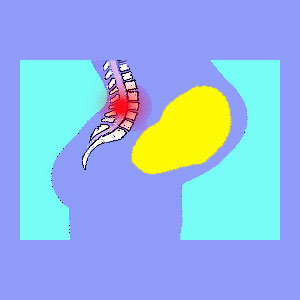
Sciatica during pregnancy is a somewhat common occurrence, as is general lower back pain. Pregnancy can be very tough on a woman’s body and enacts all sorts of changes to her anatomy and emotional mindset. Adding sciatica to this mix is just one more burden for a pregnant woman to bear.
This article will detail why sciatica is so commonly experienced by pregnant women. We will also look into the solutions for many of the most prevalent sources of sciatic nerve symptoms.
Being Pregnant with Sciatica
Typically, pregnancy related sciatica symptoms will resemble mild to moderate forms of the condition in any other affected patient, with a few crucial differences. There will be pain in the lower back and maybe in between the shoulder blades and in the mid back region. There is likely to be radiating pain in the upper legs, knees, ankles and feet. Some tingling and weakness might exist in the legs, but numbness is especially common in the buttocks and upper legs.
Many women also experience bladder and bowel related symptoms, such as mild incontinence or constipation, which can make the pain syndrome even more scary.
Sciatica During Pregnancy Explanations
Pregnant women might have back pain due to any of the usual causes demonstrated by any other patient. She might injure her back doing any number of physical tasks or might have a personality type which is prone to psychosomatic sciatica pain. These conditions can affect anyone, pregnant or not. However, there are many circumstances which are pregnancy-specific and might increase the chances of suffering sciatic nerve pain during the time carrying the baby:
The baby’s head can create a number of painful conditions if it presses on a nerve or internal organ. This is especially common with a large fetus in a small woman. If the baby’s head influences any of the components of the the sciatic nerve, symptoms might be mild to excruciating.
The added weight and asymmetrical front heavy design of a pregnant woman’s body will exponentially increase the stress on her lower back. This can cause pain or exacerbate preexisting painful issues.
The hormonal changes in a woman’s body can also enact pain. Pregnancy is a time of great hormonal upheaval and sometimes these changes can be very uncomfortable, especially for women with sensitive systems.
As mentioned many times throughout the site, some sciatica complaints are caused by ischemia, not a spinal structural issue. During pregnancy, the ischemic process is particularly active, due to both physical and emotional sources. The baby’s head can rest on a major blood vessel, literally causing a huge reduction in circulation, especially in certain positions. While this does occur in some women, other patients with pregnancy-related ischemia are suffering from symptoms as a direct result of the mindbody process. Pregnant women, with their added emotional burdens, are even more prone to experiencing this psychogenic version of radicular pain.
Help for Sciatica During Pregnancy
Luckily, most sciatic nerve pain syndromes will end with the birth of the baby. If they do not cease not immediately, then they typically will within several days to weeks after the birth.
Diagnosing sciatica in pregnant women is even more difficult than in the general population, due to all the possible causes and complications. Additionally, treatment options are limited, since many, especially pharmaceutical therapy, will also affect the fetus and are therefore inappropriate.
Some women might endure continuing pain after the birth. These instances are usually blamed on a coccyx injury, especially during vaginal birth, or muscle laxity due to birth trauma. In my experience, these circumstances do cause pain in some women, but typically resolve within the indicated time frame.
For structurally-illogical pain syndromes which do not resolve after a pregnancy or worsen, I generally advise to look for a psychoemotional causation. The emotional costs of bringing a new life into this world might increase the chances for a psychogenic condition to exist or even worsen with time. In these instances, knowledge therapy may be the best treatment choice.





